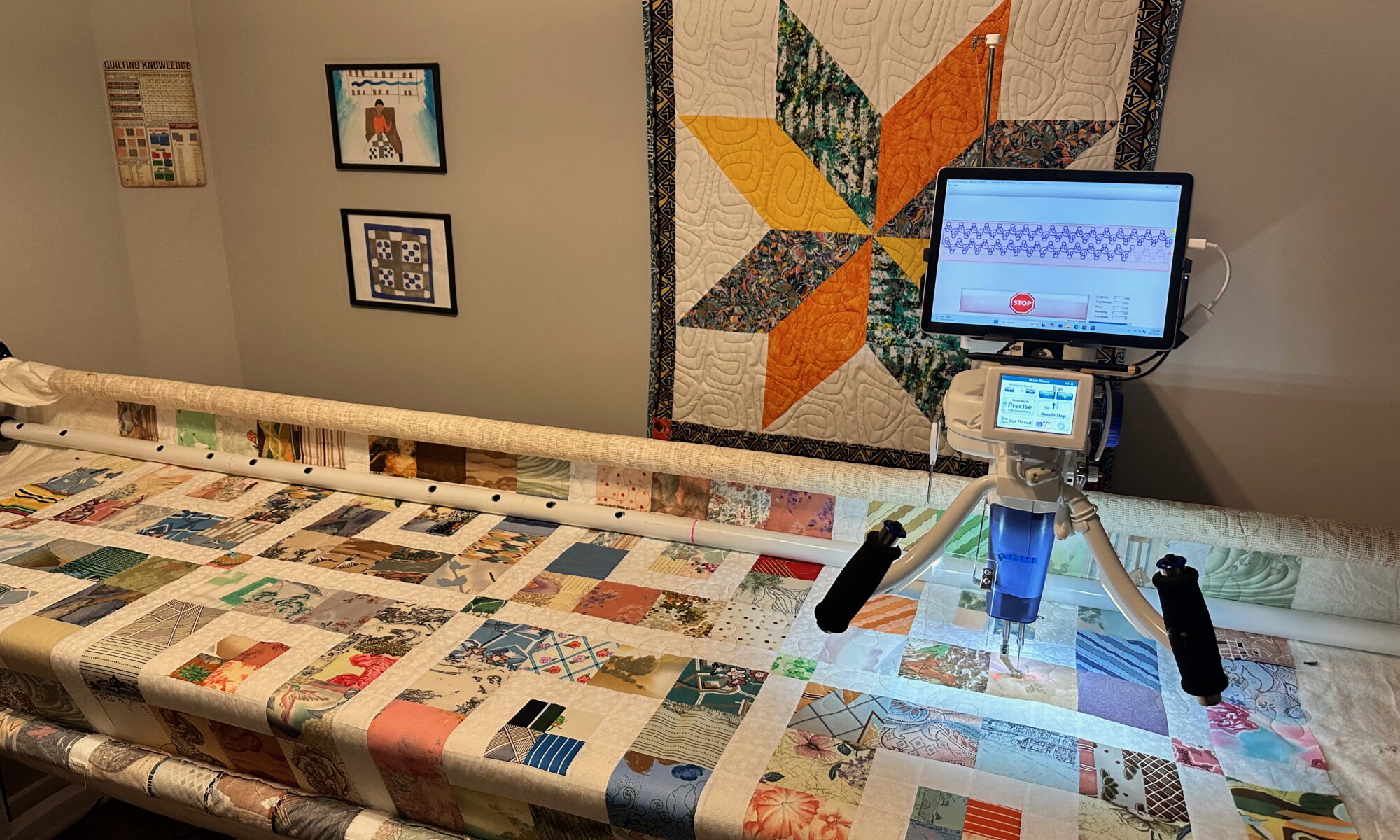When people think of quilting, they often picture stacks of fabric, thread, and a trusty old sewing machine. While that’s part of the story, my studio is also powered by some serious tech. I call it The Lab for a reason.
Over the years, I’ve built a space that blends traditional craftsmanship with modern machines and automation. This setup enables me to work faster, smarter, and more creatively while still providing every quilt with the personal attention it deserves. Here’s a peek behind the scenes.
The Longarm Quilting Machine
At the heart of my studio is my longarm machine (seen above). This is the powerhouse that lets me stitch large quilts with precision. It’s mounted on a 10-foot frame and guided either by hand or by computer for detailed pantograph work. Whether I’m working on T-shirt quilt or a memory quilt made from someone’s loved one’s clothing, this machine ensures that every stitch is strong and clean.
My 3D Printer
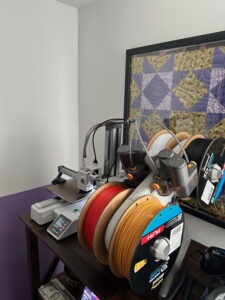
One of the most unexpected tools in my quilt studio is a four-color 3D printer. Most people don’t associate 3D printing with quilting, but in my space, it plays a key role in keeping things efficient, organized, and uniquely personalized.
I use the printer to design and produce custom tools that solve particular problems. Items such as bobbin holders, thread spool organizers, seam guides, fabric clamps, and even templates for repetitive cuts. Rather than buying one-size-fits-all accessories, I can tailor these tools to match the exact needs of my workflow. If something breaks or could be improved, I don’t wait for a shipment. I design a solution and print it in-house.
Beyond tools, I’ve also started experimenting with 3D-printed quilt labels. These can be personalized with names, dates, or messages and then sewn or heat-bonded into the backing of a quilt. It adds a modern twist to a centuries-old tradition of labeling one’s work.
Using multiple filament colors enables me to build multicolored objects in one pass, which is ideal for decorative items or branding elements, such as keychains, tags, and event display pieces.
My Smart Server
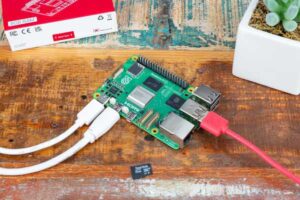
Tucked behind the scenes of my quilt studio is a small but mighty custom-built server powered by a Raspberry Pi. It’s the brain of my home automation system – and yes, that includes the studio. While quilting is traditionally seen as a hands-on, analog craft, I’ve learned that automation can quietly support creativity by removing distractions and optimizing the environment.
The server manages a network of sensors and devices throughout the studio and the rest of the house. It monitors temperature, humidity, air quality, lighting, and energy usage. Quilting requires a level of environmental consistency that people often overlook. Fabric stretches differently in humid conditions, and static can build up when the air is too dry. My system constantly makes micro-adjustments to maintain stability and comfort.
Lighting is another big one. Depending on the project, I may want bright task lighting for piecing or a softer tone for photographing finished quilts. I’ve programmed the studio lights to adjust automatically based on the time of day or the type of work I’m doing. It even knows to gradually dim if I’m still working late in the evening, nudging me toward a healthy wrap-up time.
Everything connects back to a Google Analytics dashboard I created to track trends, such as how long I spend in the studio, when I’m most productive, and which projects require the most energy or machine time. This data helps me refine my workflow, plan my schedule more efficiently, and identify burnout before it occurs.
My Brother PRX1 Embroidery Machine
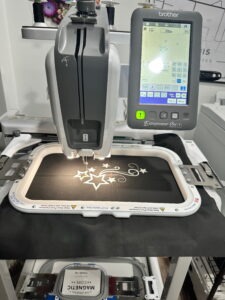
Another essential part of my studio is my Brother PRX1, a professional-grade embroidery machine that adds a new layer of customization to my quilts and memory keepsakes. This isn’t a standard, hobbyist machine. It’s fast, precise, and built for serious creative work.
I use the PRX1 to add embroidered names, dates, quotes, and messages directly onto quilt blocks or quilt labels. For memory quilts, it allows me to stitch in personal touches that help tell a story, whether that’s someone’s initials, a favorite phrase, or a tribute to a loved one. The machine’s multi-needle system and intuitive interface enable me to switch between thread colors and complex designs with ease, keeping the process efficient without compromising quality.
Beyond quilts, the embroidery machine also plays a significant role in my memory bears and custom pillows. I’ll often embroider a name or message on the chest or paw of a bear, or stitch a monogram into the center of a pillow made from cherished clothing. These little details carry a great deal of emotional weight, particularly when the item is intended to honor someone’s memory.
The PRX1 has expanded what I can offer my clients. It blends beautifully with the storytelling nature of quilting, allowing me to provide something truly unique. In a studio that thrives on the fusion of technology and tradition, this machine fits right in.
My Juki TL-2020 Platinum Edition
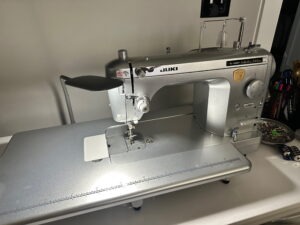
The first thing people notice about the Juki TL-2020 Platinum Edition is its appearance. This limited-edition machine features a sleek, matte platinum finish that immediately stands out in the studio. It gives off a clean, modern, and almost futuristic vibe like a high-performance sports car made for fabric. It fits right in with The Lab’s tech-forward aesthetic while honoring the legacy of classic straight-stitch machines.
But the beauty of this machine isn’t just skin-deep. Underneath that platinum shell lies an industrial-strength motor that delivers smooth, consistent stitching across a range of materials, from delicate cotton to thick denim and fleece. I primarily use it for piecing quilt tops, especially when working with upcycled garments that have varying textures and weights. The machine handles them all without hesitation.
The precision on this Juki is what makes it a staple in my studio. The foot control is responsive and intuitive, the needle positioning is rock solid, and the automatic thread cutter is one of those features I didn’t know I needed until I had it. It speeds up production without sacrificing quality.
For me, the TL-2020 PE represents the best of both worlds: form and function. It’s a statement piece in the studio and a workhorse on the table. When I sit down at this machine, I know I’m working with something built for both artistry and endurance.
Why It Matters
All this tech isn’t just about cool gadgets (though I’ll admit, that’s part of the fun). It helps me provide better service to my clients. Faster turnaround times, precise workmanship, and creative design options all stem from a studio that runs like a well-oiled machine.
But don’t get it twisted. Every quilt that leaves this studio is still made with heart, hands, and a deep respect for the memories behind it.
Want to see the machines in action? Follow me on Instagram ( @quiltsbybigwes ) for behind-the-scenes looks and project updates.

